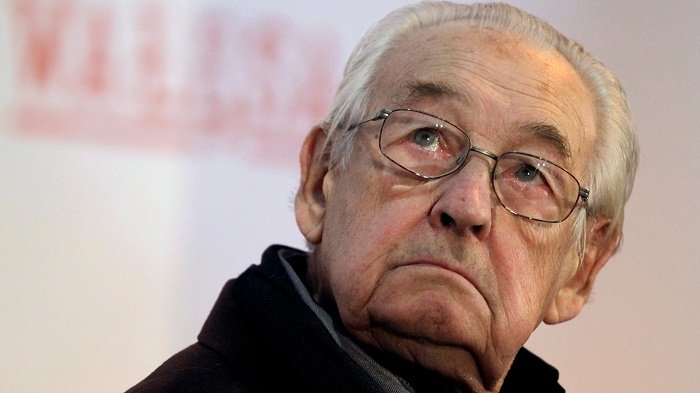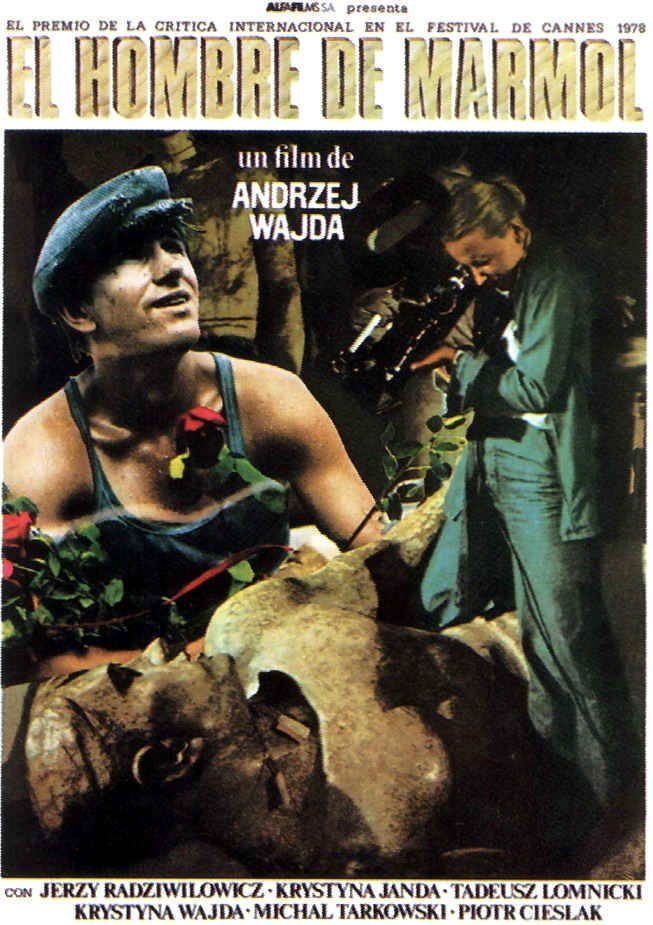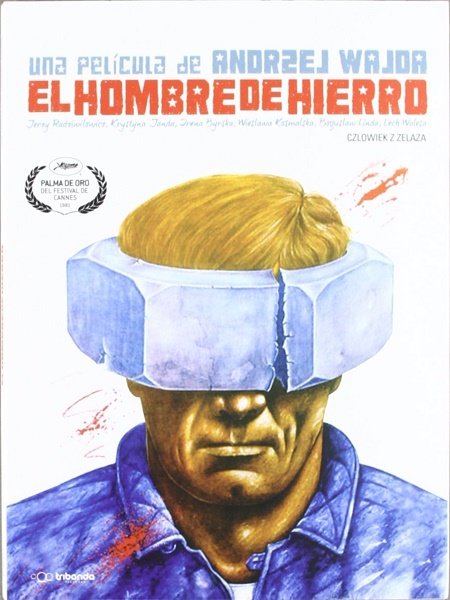Andzej Wajda: la crítica desde el cine al totalitarismo estalinista | Andzej Wajda: a film critique of Stalinist totalitarianism
ESP
Nacido el 6 de marzo de 1926, Anrzej Wajda es quizás la más importante figura del cine polaco contemporáneo, autor de una extensa y aguda producción cinematográfica (más de 40 filmes). Fue merecedor de varios premios en festivales como Cannes, Venecia, San Sebastián y Huesca, además del Óscar honorífico en 2000 y el Oso de oro del Festival de Berlín en 2006.
ENG
Born on March 6, 1926, Anrzej Wajda is perhaps the most important figure of contemporary Polish cinema, author of an extensive and sharp film production (more than 40 films). He won several awards at festivals such as Cannes, Venice, San Sebastian and Huesca, as well as the honorary Oscar in 2000 and the Golden Bear at the Berlin Festival in 2006.

En varias de sus realizaciones se dedicó a tratar el tema de la guerra, no podía ser de otro modo habiendo crecido en un contexto social que tuvo por estigmas los embates de las dos guerras mundiales, y en particular el nazismo. Uno de sus filmes más emblemáticos sobre la guerra, que recuerdo con extrañeza, es Paisaje después de la batalla (1970). Y a lo largo de su creación cinematográfica, siempre estará presente la visión crítica del incansable y resuelto artista preocupado por la libertad, en contraste con una sociedad o época que atenta contra ella, incluso antes del siglo XX, de lo que es muestra su filme Danton (1983), el líder traicionado y sacrificado de la Revolución Francesa. Hasta su último filme, Los últimos años del artista: Afterimage, de 2016, año de su muerte.
In several of his films he dealt with the theme of war, as it could not be otherwise, having grown up in a social context that had the stigmas of the two world wars, and in particular Nazism. One of his most emblematic films about the war, which I remember with strangeness, is Landscape after the battle (1970). And throughout his filmmaking, the critical vision of the tireless and resolute artist concerned with freedom, in contrast to a society or era that threatens it, will always be present, even before the 20th century, as shown in his film Danton (1983), the betrayed and sacrificed leader of the French Revolution. Until his last film, The Last Years of the Artist: Afterimage, from 2016, the year of his death.
 Fotograma de "Paisaje después de la batalla" | Still from "Landscape after the battle"
Fotograma de "Paisaje después de la batalla" | Still from "Landscape after the battle" Fotograma de "Dantón" | Still from "Danton"
Fotograma de "Dantón" | Still from "Danton"Tuvimos la suerte en mi ciudad (Cumaná, Venezuela), gracias a los cineclubes existentes entonces y a ciertos días de cine selecto en algunas salas comerciales, de ver en los años 80 y 90 gran parte de las realizaciones de Wajda. En aquel momento se forjaba en mi generación la posición crítica y de desenmascaramiento de las trampas ideológicas del llamado “socialismo”, revelado como otra cara de la barbarie. En asentar ese rechazo contribuyeron en gran medida dos filmes del director polaco: El hombre de mármol (1977) y El hombre de hierro (1981), a los que me referiré brevemente.
We were lucky in my city (Cumaná, Venezuela), thanks to the film clubs existing at that time and to certain days of select cinema in some commercial theaters, to see in the 80's and 90's most of Wajda's films. By that time, my generation was forging a critical position and unmasking the ideological traps of the so-called "socialism", revealed as another face of barbarism. Two films by the Polish director contributed greatly to this rejection: The Marble Man (1977) and The Iron Man (1981), to which I will refer briefly.

En El hombre de mármol (1977) una estudiante de cine prepara su trabajo de graduación que consistirá en un filme sobre la vida de un albañil de los años 50, Birkut, quien había sido promocionado como un ejemplo del obrero abnegado y productivo, casi un héroe del obrerismo del régimen socialista polaco, emulador del soviético estalinista. Sin embargo, había desaparecido y no se sabía nada de él. Para armar la historia y sus claves, la estudiante se vale de grabaciones censuradas y acude a entrevistas a sus amigos, a su exmujer y al cineasta que lo promovió como héroe. El trabajo de investigación será frenado por un supervisor, imponiéndose nuevamente la censura.
Como se puede notar por esta síntesis, Wajda aborda uno de los núcleos de la niebla ideológica impulsada por el estalinismo: la manipulación de la conciencia del pueblo a través de la mentira, así como el ejercicio del “borrado” o el ocultamiento de la historia y de sus personajes que han dejado de ser “útiles” para el régimen. Todo ello hecho con dedicado cuidado narrativo y una punzante ironía.
In The Marble Man (1977) a film student prepares her graduation project, which will consist of a film about the life of a bricklayer in the 1950s, Birkut, who had been promoted as an example of the self-sacrificing and productive worker, almost a hero of the Polish socialist regime's workerism, an emulator of the Stalinist Soviet one. However, he had disappeared and nothing was known about him. To piece together the story and its clues, the student uses censored recordings and interviews with his friends, his ex-wife and the filmmaker who promoted him as a hero. The research work will be stopped by a supervisor, imposing censorship once again.
As can be seen from this synthesis, Wajda tackles one of the nuclei of the ideological fog promoted by Stalinism: the manipulation of the people's conscience through lies, as well as the exercise of "erasing" or hiding history and its characters who have ceased to be "useful" to the regime. All this is done with dedicated narrative care and sharp irony.

El hombre de hierro (1981) es, en gran medida, la continuación de El hombre de mármol. Es presentado el naciente movimiento sindical Solidaridad, que lucha por los derechos laborales y civiles de los trabajadores mediante protestas localizadas en los astilleros navales de Gdansk en 1980. Un periodista será contratado por el régimen comunista para espiar y difamar a un importante dirigente del sindicato Solidaridad, que resulta ser el hijo del héroe de El hombre de mármol. En este filme reaparece la estudiante de cine y además es presentado el real e histórico líder de Solidaridad, Lech Walesa, quien, cuando se produzca el cambio político en Polonia, será presidente de la república.
*The Iron Man" (1981) is, to a large extent, a continuation of "The Marble Man". It features the nascent trade union movement Solidarity, which fights for workers' labor and civil rights through localized protests at the Gdansk shipyards in 1980. A journalist will be hired by the communist regime to spy and defame an important leader of the union Solidarity, who happens to be the son of the hero of The Marble Man. In this film, the film student reappears and the real and historical leader of Solidarity, Lech Walesa, who, when the political change takes place in Poland, will become president of the republic, is also introduced.
Referencias | References:
https://es.wikipedia.org/wiki/Andrzej_Wajda
https://en.wikipedia.org/wiki/Andrzej_Wajda
https://es.wikipedia.org/wiki/El_hombre_de_m%C3%A1rmol
https://es.wikipedia.org/wiki/El_hombre_de_hierro_(pel%C3%ADcula)
https://www.cinemaldito.com/el-hombre-de-hierro-wajda/

Gracias por su lectura | Thank you for reading.




https://twitter.com/1584249800207253506/status/1632958049164902404
The rewards earned on this comment will go directly to the people sharing the post on Twitter as long as they are registered with @poshtoken. Sign up at https://hiveposh.com.
The movie Danton (1983) is an extraordinary depiction of how the people of the country struggled during the French Revolution and the people who betrayed the country during the war. War for the country, movement, struggle, sacrifice, abandonment, intense competition of politics and victory and defeat for the country and the people of the country can be seen and known through the movie. Nice movie, thanks for writing about such a nice movie.
Also in "The Marble Man (1977)" the story of a great sacrificial hero can be seen and in "The Iron Man" (1981) a powerful form of justice can be seen and known. Thank you for your excellent writing.
Thanks for your visit and for such an appropriate comment. Regards, @sheikhshaon.
Great to read how Wajda films were received in Wenezuela!
Thanks for your visit, @helcim.